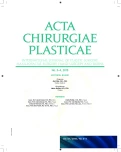A-12 Low osteoplastic amputation of the calf using vascularized bone graf
Authors:
P. Christodoulou; B. Zálešák; R. Lysák
Authors‘ workplace:
Department of Plastic and Aesthetic Surgery, University Hospital in Olomouc, Czech Republic
Published in:
ACTA CHIRURGIAE PLASTICAE, 57, 3-4, 2015, pp. 63-64
Category:
Selected abstracts from the 36th national congress of the czech society plastic surgery with international participation
Below knee amputation is an irreversible, mutilating procedure with significant psychical and somatic consequences for the patient. Standard procedure of below knee amputation preserves proximal, relatively short and biomechanically unsuitable stump, which is poorly accepted by the patients psychically. Since the contact area of the prosthesis is small, due to a relatively great nominal pressure load, it results in excessive overload of soft tissues and therefore the patient has a lower lever for the prosthesis control. Last but not least, during classical amputation is missing the distal fixation of fibula, which results in shearing movements of the calf bones during gait (i.e. chop-sticking). This results in greater irritation of soft tissues, pain and rotation instability in the prosthesis. An alternative is preservation of a long calf stump, which is better tolerated by the patient and it preserves lever for transfer force to the prosthesis. This solution is beneficial for the patient, it is more technically demanding for the surgeon and it is more complicated for the prosthetistto create a well fitting prosthesis.
Due to the long amputation stump, it is surgically necessary to achieve firm connection of both calf bones to prevent shearing forces between the long tibia and fibula. For this goal is standardly used non-vascularized bone graft (potentially problematic healing) or there is so called Ertl amputation performed, when bone marrow cavity of both amputated bones is bridged by a periosteal or osteo-periosteal flap, which ossificates in time. Even here it is advantageous to perform greater shortening of calf bones in order to create connection of the aforementioned flap.
The most advantageous method to achieve distal fusion of both calf bones with preservation of the longest stump possible, is the use of vascularized bone graft from fibula, which is shifted onto fibula after close-wedge osteotomy and fixed. This method, although technically more demanding, ensures rapid and safe synostosis and enables the surgeon to preserve the longest stump, which is associated with several advantages. Firstly, low below knee amputation is better accepted by the patient. Vascularized graft provides rapid and solid fusion of both bones without the risks resulting from shearing movements (chop-sticking) at the border of fibula/tibia and the patient still has longer lever to control the prosthesis, which is a clear and long term biomechanical advantage. Contact area is greater, which results in reduced nominal pressure load on skin and reduced risk of pressure sores. Rapid healing enables early rehabilitation. (Fig. 12.1, 12.2, 12.3.)



Labels
Plastic surgery Orthopaedics Burns medicine TraumatologyArticle was published in
Acta chirurgiae plasticae

2015 Issue 3-4
- Metamizole vs. Tramadol in Postoperative Analgesia
- Metamizole at a Glance and in Practice – Effective Non-Opioid Analgesic for All Ages
- Current Insights into the Antispasmodic and Analgesic Effects of Metamizole on the Gastrointestinal Tract
- Spasmolytic Effect of Metamizole
- Obstacle Called Vasospasm: Which Solution Is Most Effective in Microsurgery and How to Pharmacologically Assist It?
Most read in this issue
- 36th NATIONAL CONGRESS OF THE CZECH SOCIETY OF PLASTIC SURGERY WITH INTERNATIONAL PARTICIPATION
- Dorsoradial forearm flap with silicone bone spacer in reconstruction of A combined THUMB injury – case report
-
ZORA JANŽEKOVIČ
(September 30, 1918 – March 17, 2015) - Editorial
